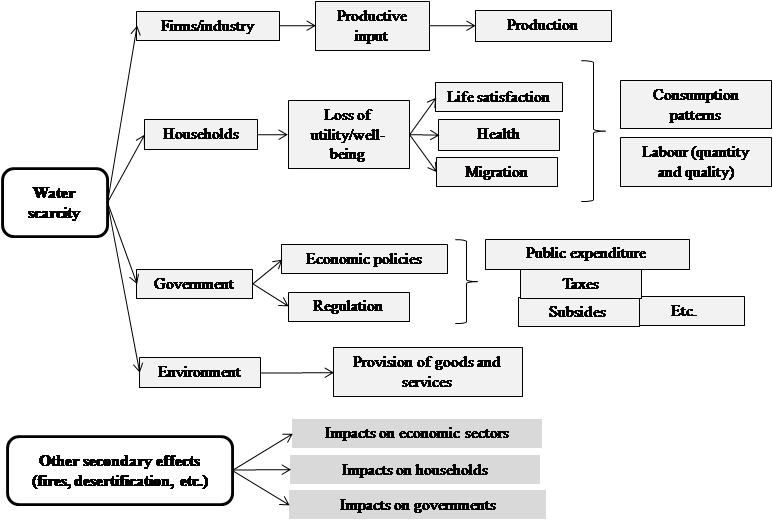Key science findings
-
Droughts are a specific type of natural hazard. Economic assessments of drought impacts require a framework capable of accounting for its unique and particular characteristics.
-
Traditional frameworks used to assess the impacts of natural hazards do not adequately capture all of the factors that contribute to the economic impacts of droughts, such as: the importance of the level, and composition, of hydraulic capital; the dispersion of impacts across different economic activities and agents; the temporality of drought events; and the critical importance of policy-making in shaping the short and long-term economic impacts of droughts. Failure to take account of these factors raises a risk that estimates of economic impact of drought may be biased.
-
We develop a new conceptual framework that takes account of the unique and particular characteristics of drought. The conceptual framework is based around two sources of drought: ‘green water’ and ‘blue water’; each of which can result in different economic impacts. Equally important, the framework also takes account of policy-decisions -either by public administrations, water suppliers or private actors- and does not automatically assume proportional losses based on the climate conditions.
-
We have also developed a scenario-based assessment framework which can be used to empirically estimate the economic impacts of future droughts under a range of climate and policy scenarios. We argue that such a framework is particularly important for estimating the economic consequences of potential future droughts because extreme droughts are rare events but are a growing concern for policy makers and other economic actors in many countries.
-
Applying this scenario-based framework to the UK economy we estimate that, depending on the severity of the drought event and short-term policy choices, the impacts could range from 0.35% to 4.3% of total output. Different long-term policy choices could mitigate these impacts for drought events with similar severity and duration.
Introduction
Economic impacts of drought can be large and far-ranging. The quantification of the potential magnitude and distribution of economic losses during droughts is important to inform trade-offs between uses of water and to help decision makers, water suppliers and private actors understand the scale of economic risks and need for investment and regulatory action. The economic impacts of droughts on specific economic sectors and the overall economy is assessed, providing output measures such as: changes in relative input or production costs; and changes in relative final output or production levels. Analysis of the economic impacts of droughts has focused upon domestic and commercial water consumers and upon major industrial abstractors, notably electricity generation. This is important as in England and Wales, the electricity sector is responsible for 40% of non-tidal surface water abstractions. When sufficient cooling is not possible, power station operators are required to ‘ramp down’ the generation output in order to reduce cooling demand. The risk of this occurring is computed.
Research methods
A limitation of most empirical studies on economic impacts of drought is that they are not applied within an explicit conceptual framework that sets out the important characteristics of droughts, such as: the level, and composition, of hydraulic capital; the dispersion of economic impacts across different economic activities and agents; the temporality of drought events; and the critical importance of policy-making in shaping the short and long-term economic impacts of droughts. While such a focus might be appropriate when assessing the economic impacts of past droughts, such an approach is not fit for purpose when it comes to assessing future, potential droughts.

Fig. 1 differentiates between two types of impacts. The first type of impact is related to how a lack of water affects different economic agents such as industry, households, government and the environment. The second type of impact refers to the secondary effects of a drought from fires, desertification, migration etc. Each of these secondary effects needs a specific framework of economic analysis beyond the effects of the lack of water on the economic systems.
In recognition of the increasing importance in the policy discourse of quantifying the range of possible economic impacts of potential droughts, Freire-González et al (2017b) develop, and then apply, a scenario-based framework to empirically estimate the economic impacts of future droughts under a range of assumed climate and policy conditions. Three types of scenarios are used to estimate impacts within the framework: 1) assumptions about how drought impacts on the availability of green water available to keep soil moist; 2) assumptions about the amount of blue water available for abstractors; and 3) decisions that policy-makers take, applying water restrictions to specific agents when managing blue water resources. The combination of the climate scenarios and the policy scenarios collectively determine the final economic impact of a given drought event.
In estimating potential impacts, Freire-González et al (2017b) focus on three hypothetical drought events: a low severity drought, a medium severity drought and a high severity drought. Each drought event assumes different hypothetical reductions in green water and blue water, and assumes a specific fixed level and composition of hydraulic capital stock. Specifically, they apply the framework to estimate economic impacts on the UK economy for 10 different policy scenarios, from less restrictive to more restrictive ones. For each of the scenarios identified the indirect and economy-wide impacts are estimated applying a supply-side I-O model, which incorporates estimates of gross value added (GVA) changes in response to variation in water availability of different economic sectors. However, the scenario-based framework is capable of being used with other modelling approaches (such as CGE or macroeconometric approaches) and to estimate other macroeconomic indicators of impact such as changes in sectorial GVA, employment, salaries etc.
Results
A number of key results emerge from this research that should guide the development of richer conceptual and analytical frameworks for assessing the economic impacts of droughts:
-
First, we have identified two sources of drought and shown how they relate to economic impacts. The first source is a ‘green water’ drought, which is mainly determined by climate conditions, and can have significant and direct impact mainly on agricultural and other green-water reliant industries. A second source of impact comes from choices made in relation to the water storage, interconnection and production capacity (‘blue water’). Critically, while a blue water drought can be related to climate conditions, it need not be, and it is possible to develop sufficient blue water reserves (hydraulic capital) to sustain an economy through a prolonged green water drought.
-
Second, we have identified a number of key characteristics of drought that differentiate them from other natural hazards in economic terms. Important among these is the critical role of long-term and short-term policy decisions.
-
Third, we show that there is considerable scope for policy choices in relation to blue water to mitigate the economic impacts from drought. However, many of these policy choices are not costless, and the optimal level of blue water availability (i.e.: resilience) is likely to reflect choices about the level of resilience that a society is prepared to pay for and tolerate.
-
Finally, we show that policy decisions taken within a period of drought –for example, when introducing water restrictions, who they should apply to and how long they should last– can be significant in terms of conditioning the economic impacts of drought both at the macroeconomic level, and in terms of different economic sectors and activities.
The application of the scenario-based assessment framework to a hypothetical case study of the UK economy allows us to estimate the aggregated output losses under different climate and policy scenarios. For the 30 different hypothetical climate and policy scenarios examined losses range from 0.35% to 4.3% of total output of the UK economy. As might be expected, more extreme drought events and policy responses are more likely to have greater short-term impacts on total output. A particularly important result of this analysis is that for a given climatic condition (such as a high severity drought), the economic impact can vary significantly depending on long and short term policy choices.
Further information
Visit the Droughts, people and management dashboard here
Publications
-
Freire-González, J., Decker, C. and J.W. Hall (2017a). The economic impacts of droughts: a framework for analysis. Ecological Economics (in print).
-
Freire-González, J., Decker, C. and J.W. Hall (2017b). A scenario-based framework for assessing the economic impacts of potential droughts. (Manuscript under review).
-
Freire-González, J., Decker, C. and J.W. Hall (2016). Linear programming input-output method to determine optimal water allocations in periods of water scarcity and drought (Manuscript under review).



